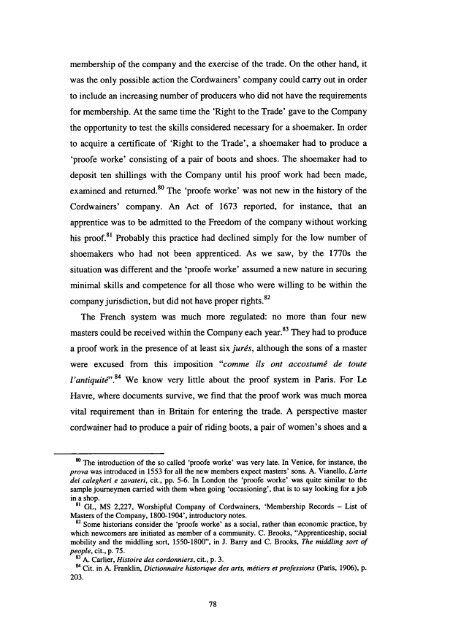The Boot and Shoe Trades in London and Paris in the Long Eighteenth Century
The Boot and Shoe Trades in London and Paris in the Long Eighteenth Century
The Boot and Shoe Trades in London and Paris in the Long Eighteenth Century
You also want an ePaper? Increase the reach of your titles
YUMPU automatically turns print PDFs into web optimized ePapers that Google loves.
membership of <strong>the</strong> company <strong>and</strong> <strong>the</strong> exercise of <strong>the</strong> trade. On <strong>the</strong> o<strong>the</strong>r h<strong>and</strong>, it<br />
was <strong>the</strong> only possible action <strong>the</strong> Cordwa<strong>in</strong>ers' company could carry out <strong>in</strong> order<br />
to <strong>in</strong>clude an <strong>in</strong>creas<strong>in</strong>g number of producers who did not have <strong>the</strong> requirements<br />
for membership. At <strong>the</strong> same time <strong>the</strong> 'Right to <strong>the</strong> Trade' gave to <strong>the</strong> Company<br />
<strong>the</strong> opportunity to test <strong>the</strong> skills considered necessary for a shoemaker. In order<br />
to acquire a certificate of 'Right to <strong>the</strong> Trade', a shoemaker had to produce a<br />
'proofe worke' consist<strong>in</strong>g of a pair of boots <strong>and</strong> shoes. <strong>The</strong> shoemaker had to<br />
deposit ten shill<strong>in</strong>gs with <strong>the</strong> Company until his proof work had been made,<br />
exam<strong>in</strong>ed <strong>and</strong> returned. 80 <strong>The</strong> 'proofe worke' was not new <strong>in</strong> <strong>the</strong> history of <strong>the</strong><br />
Cordwa<strong>in</strong>ers' company. An Act of 1673 reported, for <strong>in</strong>stance, that an<br />
apprentice was to be admitted to <strong>the</strong> Freedom of <strong>the</strong> company without work<strong>in</strong>g<br />
his proof. 8' Probably this practice had decl<strong>in</strong>ed simply for <strong>the</strong> low number of<br />
shoemakers who had not been apprenticed. As we saw, by <strong>the</strong> 1770s <strong>the</strong><br />
situation was different <strong>and</strong> <strong>the</strong> 'proofe worke' assumed a new nature <strong>in</strong> secur<strong>in</strong>g<br />
m<strong>in</strong>imal skills <strong>and</strong> competence for all those who were will<strong>in</strong>g to be with<strong>in</strong> <strong>the</strong><br />
company jurisdiction, but did not have proper rights.82<br />
<strong>The</strong> French system was much more regulated: no more than four new<br />
masters could be received with<strong>in</strong> <strong>the</strong> Company each year. 83 <strong>The</strong>y had to produce<br />
a proof work <strong>in</strong> <strong>the</strong> presence of at least six jurés, although <strong>the</strong> sons of a master<br />
were excused from this imposition "comme us ont accostumé de toute<br />
l'antiquité". 84 We know very little about <strong>the</strong> proof system <strong>in</strong> <strong>Paris</strong>. For Le<br />
Havre, where documents survive, we f<strong>in</strong>d that <strong>the</strong> proof work was much morea<br />
vital requirement than <strong>in</strong> Brita<strong>in</strong> for enter<strong>in</strong>g <strong>the</strong> trade. A perspective master<br />
cordwa<strong>in</strong>er had to produce a pair of rid<strong>in</strong>g boots, a pair of women's shoes <strong>and</strong> a<br />
80 <strong>The</strong> <strong>in</strong>troduction of <strong>the</strong> so called 'proofe worke' was very late. In Venice, for <strong>in</strong>stance, <strong>the</strong><br />
prova was <strong>in</strong>troduced <strong>in</strong> 1553 for all <strong>the</strong> new members expect masters' sons. A. Vianello, L'arte<br />
dei calegheri e zavateri, cit., pp. 5-6. In <strong>London</strong> <strong>the</strong> 'proofe worke' was quite similar to <strong>the</strong><br />
sample journeymen carried with <strong>the</strong>m when go<strong>in</strong>g 'occasion<strong>in</strong>g', that is to say look<strong>in</strong>g for a job<br />
<strong>in</strong> a shop.<br />
81 GL, MS 2,227, Worshipful Company of Cordwa<strong>in</strong>ers, 'Membership Records - List of<br />
Masters of <strong>the</strong> Company, 1800-1904', <strong>in</strong>troductory notes.<br />
82 Some historians consider <strong>the</strong> 'proofe worke' as a social, ra<strong>the</strong>r than economic practice, by<br />
which newcomers are <strong>in</strong>itiated as member of a community. C. Brooks, "Apprenticeship, social<br />
mobility <strong>and</strong> <strong>the</strong> middl<strong>in</strong>g sort, 1550-1800", <strong>in</strong> J. Barry <strong>and</strong> C. Brooks, <strong>The</strong> middl<strong>in</strong>g sort of<br />
people, cit., p. 75.<br />
83 A. Carlier, Histoire des cordonniers, cit., p. 3.<br />
Cit. <strong>in</strong> A. Frankl<strong>in</strong>, Dictionnaire historique des arts, métiers et professions (<strong>Paris</strong>, 1906), p.<br />
203.<br />
78


